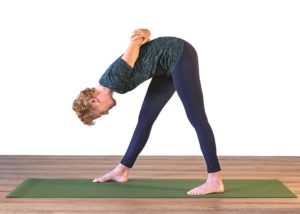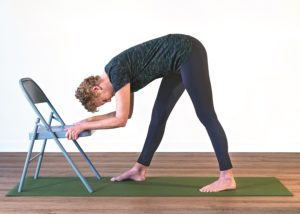February can be a sedentary time of year for many of us. Short days, long nights, and cold weather and wind can keep us indoors and sitting around more. On the other hand, some people find themselves doing activities that they don’t do the rest of the year: skiing, skating, or snowshoeing.
Whether you’ve been a sitter or a skier, you might find that your hamstrings — the group of muscles that run down the back of your legs from the hips to the knees — are tight. And that can cause stiffness and limit your mobility. Lower back pain, bad posture, imbalances in your musculature, or knee pain can often be traced to this same muscle group.
I have just the remedy for this: Parsvottanasana. Also called the Pyramid Pose or Standing Runner’s Stretch, this pose is a deep opener for the hamstrings, and it is not just for runners. It’s a pose that can also lengthen your spine and side body and improve your powers of concentration.

Begin by standing at the far end of your yoga mat or another nonslip surface. Stand with your feet parallel to one another and hip width apart — that is, about four to eight inches apart, depending on your size.
Take a step forward with your right foot, placing it two to three feet ahead of you, depending on the length of your legs and your flexibility. Now check to see if you’re feeling stable. If not, you may need to widen your stance slightly. Put your hands on your hips.
Angle your left foot out slightly and square your hips, so that your hip bones are facing forward. Press into your feet. Feel the muscles of the legs engaging. Do not lock your knees; instead, keep a slight bend in them and lift the muscles in your thigh up and away from your kneecap. From here, bring your awareness to your pubic bone. Lift the pubic bone and tuck the tailbone slightly down towards the floor.
Elongate the spine by lifting out of the waist and staying long all the way to the crown of the head. Take a deep breath in, then, as you exhale, lift the tailbone and hinge forward from your hips. Continue forward until you feel a good stretch in your hamstrings. Keep your head in line with your spine as you lean forward, then release your forehead gently, being mindful not to strain your neck.
Breathe and notice where you are feeling the pose in your body. Are your hamstrings talking to you? If this is challenging for you, place a chair in front of you and put your hands on either side of the seat to help support your weight and stabilize the pose. Make sure the chair is sturdy and not likely to slide forward — it helps to have all four chair legs securely on your yoga mat.

If you feel like you can go deeper, continue to hinge at the hips, reaching your fingertips to your shin, your foot, or to the floor. Take a few breaths. There is no need to push yourself as deeply as possible. Going to 60 or 70 percent of your range will benefit you sufficiently and guard against overstretching the muscles, which can result in injury.
Stretching should not be painful. Find your edge with just the right amount of sensation, without sharp pain, electrical sensations, or numbness. Then hold that edge for a few breaths.
To release the pose, bring your hands to your leg and come up with a straight spine, using the leg or the chair for support. Relax your body as you stand and notice the imprint of the pose on this side.
If this felt relatively easy to do and you’d like to challenge yourself more, you may want to add the hand and arm variations. You might rest your arms behind your back, hands clasping opposite elbows. You may also leave your hands resting on your sacrum. In an advanced version of the pose, the arms are behind the back, palms pressed into each other in a reverse prayer position — but proceed with caution, as this may put strain on your hands and forearms.
Whether or not you are using the arms, be sure to repeat the pose on the other side. When you have finished the stretch on both sides, notice: was one side tighter than the other? If so, you might want to do that side again.
After practicing Parsvottanasana, consider the sensations in your back and legs. Doing this might not seem natural at first, but body awareness is something to cultivate. It will help you enjoy your yoga practice and avoid injuries. Take a walk around the room and notice what you feel.
